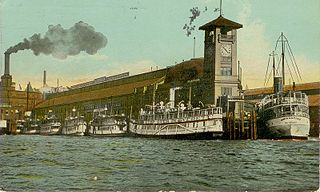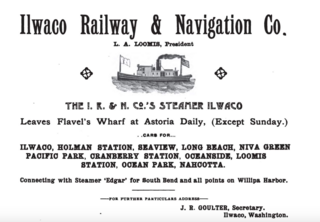Design and construction
North Pacific was built in San Francisco for E.A. and L.M. Starr. [1] The Starrs were pioneer businessmen in Portland. The Starrs had been unsuccessfully trying to compete with Finch and Wright, first with the sidewheeler Alida and then with the small steamer Isabel. The Starrs brought North Pacific to Puget Sound in 1871 to compete with the firm of D.B. Finch and Capt. Tom Wright (1828–1906). Finch and Wright had run the pioneer sidewheeler Eliza Anderson on the Sound, and had recently replaced the Anderson with the faster sidewheeler Olympia (later known as the Princess Louise).
North Pacific was 166.8 ft (50.84 m) long, with a beam of 29 ft (8.84 m) and 10.3 ft (3.14 m) depth of hold. [2] [3] North Pacific was assessed at 488.73 gross register tons , with "tons" in this instance being a measure of volume and not weight. [2] The official merchant vessel registry number was 18685. [2]
North Pacific was driven by a single-cylinder walking beam engine, 40-inch-diameter (1,000 mm) piston, 120-inch (3,000 mm) stroke [1]
Operation on Puget Sound
When North Pacific arrived at Puget Sound in June 1871, the vessel was considered to be the finest (and was certainly one of the largest) vessels yet to operate in the area. [1] On June 27, 1871, North Pacific raced Olympia across the Strait of Juan de Fuca from Victoria, British Columbia to Port Townsend, Washington, beating Olympia by three minutes. A lot of money was wagered on the outcome, and the bets were paid off at Port Townsend. Newell described the scene:
The black smoke poured out of the paint-blistered funnels in marcelled black waves to streak away aft with the speed of the steamers. The great iron walking-beams blurred up and down while the thundering paddle-buckets churned the water at the ships' side into roaring waterfalls that tumbled astern to form broad white wakes on the blue straits. [1] : 57
The steamers continued racing however all the way to Olympia, Washington and the Olympia was able to edge out the North Pacific over this longer run. Even so, with the North Pacific the Starrs were finally able to best Finch and Wright, who accepted $7,500 from the Starrs to withdraw Olympia from the Puget Sound service, and take her south to California. [1] [3]

The Puget Sound mosquito fleet was a multitude of private transportation companies running smaller passenger and freight boats on Puget Sound and nearby waterways and rivers. This large group of steamers and sternwheelers plied the waters of Puget Sound, stopping at every waterfront dock. The historical period defining the beginning and end of the mosquito fleet is ambiguous, but the peak of activity occurred between the First and Second World Wars.

The steamboat Monticello (2) operated in the early 1900s as part of the Puget Sound Mosquito Fleet. The vessel went through several reconstructions and remained in service until 1962, when she was lost in Alaska waters. Her later names were Penaco and Sea Venture. (This Puget Sound steamer should not be confused with the smaller Monticello, which also ran on Puget Sound, but was built in 1895 for Captain Z.J. Hatch of the Monticello Steamship Company.

The steamboat George E. Starr operated in late 19th century as part of the Puget Sound Mosquito Fleet and also operated out of Victoria, B.C. Geo. E. Starr also served for a time in California and on the Columbia River.

The steamboat Yosemite operated for almost fifty years on San Francisco Bay, the Sacramento River, inland coastal waters and the lower Fraser River in British Columbia, and Puget Sound.

Olympian was a large side-wheel inland steamship that operated in the Pacific Northwest and Alaska. Olympian operated from early 1884 to late 1891 on the Columbia River, Puget Sound, and the Inside Passage of British Columbia and Alaska.

The PS Eliza Anderson operated from 1858 to 1898 mainly on Puget Sound, the Strait of Georgia, and the Fraser River but also for short periods in Alaska. She was generally known as the Old Anderson and was considered slow and underpowered even for the time. Even so, it was said of her that "no steamboat ever went slower and made money faster." She played a role in the Underground Railroad and had a desperate last voyage to Alaska as part of the Klondike Gold Rush.

The steamboat Rosalie operated from 1893 to 1918 as part of the Puget Sound Mosquito Fleet, also operating out of Victoria, B.C. In 1898, Rosalie went north with many other Puget Sound steamboats to join the Klondike Gold Rush.

Wilson G. Hunt was a steamboat that ran in the early days of steam navigation on Puget Sound and Sacramento, Fraser, and Columbia Rivers. She was generally known as the Hunt during her years of operation. She had a long career on the west coast of the United States and Canada, and played an important transportation role in the California Gold Rush; it also transported the Governor and the state legislature as the state capital of California moved from Benicia to Sacramento in 1854.

The sidewheeler Idaho was a steamboat that ran on the Columbia River and Puget Sound from 1860 to 1898. There is some confusion as to the origins of the name; many historians have proposed it is the inspiration for the name of the State of Idaho. Considerable doubt has been cast on this due to the fact that it is unclear if the boat was named before or after the idea of 'Idaho' as a territory name was proposed. John Ruckel also allegedly stated he had named the boat after a Native American term meaning 'Gem of the Mountains' he got from a mining friend from what is now Colorado territory. This steamer should not be confused with the many other vessels of the same name, including the sternwheeler Idaho built in 1903 for service on Lake Coeur d'Alene and the steamship Idaho of the Pacific Coast Steamship Line which sank near Port Townsend, Washington.

The Enterprise was an early steamboat operating on the Willamette River in Oregon and also one of the first to operate on the Fraser River in British Columbia. This vessel should not be confused with the many other vessels, some of similar design, also named Enterprise. In earlier times, this vessel was sometimes called Tom Wright's Enterprise after one of her captains, the famous Tom Wright.

Otter was a wooden sternwheel steamboat that was used in Puget Sound and briefly on the Columbia and Stikine rivers from 1874 to 1897.

Inland Flyer was a passenger steamboat that ran on Puget Sound from 1898 to 1916. From 1910 to 1916 this vessel was known as the Mohawk. The vessel is notable as the first steamer on Puget Sound to use oil fuel. Inland Flyer was one of the most famous vessels of the time on Puget Sound.

General Miles was a steamship constructed in 1882 which served in various coastal areas of the states of Oregon and Washington, as well as British Columbia and the territory of Alaska. It was apparently named after US General Nelson A. Miles.

Sioux was a steamship which was operated on Puget Sound and the Strait of Juan de Fuca from 1912 to 1941. From 1924 to 1941, following reconstruction, the vessel operated as an auto ferry under the name Olympic. During the Second World War (1941-1945) this vessel was taken under the control of the U.S. Army and renamed the Franklin R. Leisenburg. The Liesenburg served as a ferry in the Panama Canal area under Army control, and then was sold to a firm which ran the vessel on the Surinam river in South America.

Princess Louise was a sidewheel steamboat built in 1869. From 1869 to 1879 this ship was named Olympia. In 1879 the name was changed to Princess Louise, after Princess Louise, Duchess of Argyll, a daughter of Queen Victoria who was married to Marquess of Lorne (1845-1914), Governor General of Canada from 1878 to 1883. Princess Louise was the last sidewheeler to be operated commercially on the coast of British Columbia.

Emma Hayward commonly called the Hayward, was a steamboat that served in the Pacific Northwest. This vessel was once one of the finest and fastest steamboats on the Columbia River and Puget Sound. As newer vessels came into service, Emma Hayward was relegated to secondary roles, and, by 1891, was converted into a Columbia river tow boat.

Wenat was a stern-wheel steamboat that, under the name Swan, was built and operated, briefly, on the Tualatin River, in the state of Oregon. In 1858, Swan was sold, moved to the lower Willamette River, renamed Cowlitz, and placed on a route between Portland, Oregon the Cowlitz River.

Ilwaco was a small riverine and coastal steamship built in 1890 which was operated as a passenger vessel for the Ilwaco Railway and Navigation Company, and later served in other roles, including tow and freight boat, cannery tender and fish packing vessel. Ilwaco was originally named Suomi.

Telegraph was a sternwheel-driven steamboat built in 1903 in Everett, Washington. Except for the summer of 1905, from 1903 to 1912, Telegraph served in Puget Sound, running mainly on the route from Seattle to Everett, and also from Seattle to Tacoma and Olympia, Washington.





















